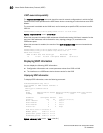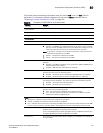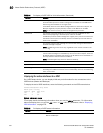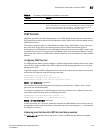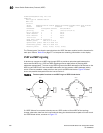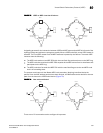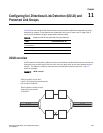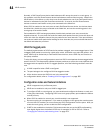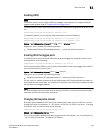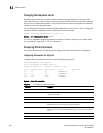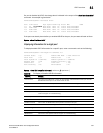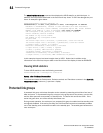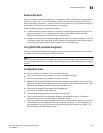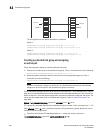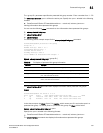
384 PowerConnect B-Series FCX Configuration Guide
53-1002266-01
UDLD overview
11
Normally, a Dell PowerConnect device load balances traffic across the ports in a trunk group. In
this example, each Dell PowerConnect device load balances traffic across two ports. Without the
UDLD feature, a link failure on a link that is not directly attached to one of the Dell PowerConnect
devices is undetected by the Dell PowerConnect devices. As a result, the Dell PowerConnect
devices continue to send traffic on the ports connected to the failed link.
When UDLD is enabled on the trunk ports on each Dell PowerConnect device, the devices detect
the failed link, disable the ports connected to the failed link, and use the remaining ports in the
trunk group to forward the traffic.
Ports enabled for UDLD exchange proprietary health-check packets once every second (the
keepalive interval). If a port does not receive a health-check packet from the port at the other end
of the link within the keepalive interval, the port waits for two more intervals. If the port still does
not receive a health-check packet after waiting for three intervals, the port concludes that the link
has failed and takes the port down.
UDLD for tagged ports
The default implementation of UDLD sends the packets untagged, even across tagged ports. If the
untagged UDLD packet is received by a third-party switch, that switch may reject the packet. As a
result, UDLD may be limited only to Dell PowerConnect devices, since UDLD may not function on
third-party switches.
To solve this issue, you can configure ports to send out UDLD control packets that are tagged with a
specific VLAN ID. This feature also enables third party switches to receive the control packets that
are tagged with the specified VLAN. For tagged operation, all of the following conditions must be
met:
• A VLAN is specified when UDLD is configured
• The port belongs to the configured VLAN as tagged member
• All the devices across the UDLD link are in the same VLAN
For configuration details, refer to “Enabling UDLD for tagged ports” on page 385.
Configuration notes and feature limitations
• UDLD is supported only on Ethernet ports.
• UDLD can be enabled on only one VLAN for tagged port.
• To configure UDLD on a trunk group, you must enable and configure the feature on each port
of the group individually. Configuring UDLD on a trunk group primary port enables the feature
on that port only.
• When UDLD is enabled on a trunk port, trunk threshold is not supported.
• Dynamic trunking is not supported. If you want to configure a trunk group that contains ports
on which UDLD is enabled, you must remove the UDLD configuration from the ports. After you
create the trunk group, you can re-add the UDLD configuration.
• If MRP is also enabled on the device, Dell recommends that you set the MRP preforwarding
time slightly higher than the default of 300 ms; for example, to 400 or 500 ms. Refer to
“Changing the hello and preforwarding times” on page 351.



